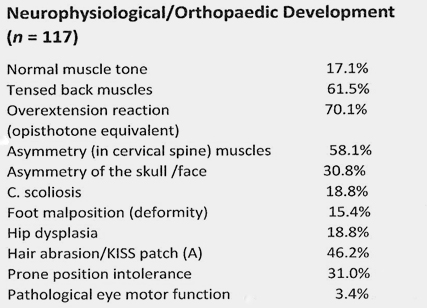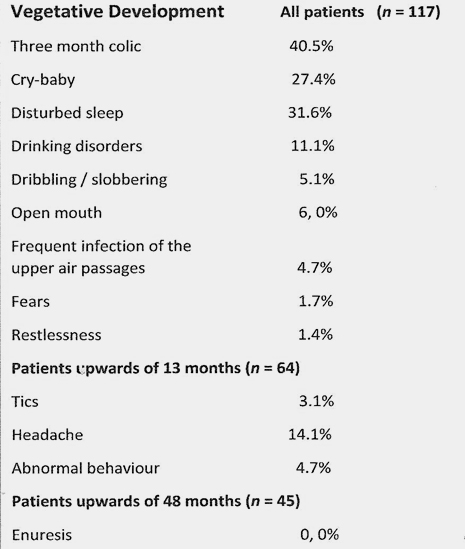|
Startseite
|
|||||||||||||||
This is a translation (as near as possible) of the original article Kopfgelenk-induzierte Symmetriestörungen und deren Folgepathologien (Pilot Study) L.E-.Koch S.Graumann-Brunt This pilot study appeared in the journal 'Manuelle Medizin'/ Springer Verlag 1999 – 37: 67 – 78 and can be read there; it is quoted here in English "Kinetic Imbalances due to Suboccipital Strain and their Pathological Sequelae" Summary A unilaterality in sensory and motor functions in infants resulting in movement and perception disorders are aetiologically attributed to KISS syndrome. A questionnaire was used to collect and systematically arrange evidence found in anamneses and clinical examinations that was attributable to KISS syndrome. A review of the internal consistency revealed a structure identifying six characteristic groups. The results were striking in that the nature of the asymmetry of the upper cervical joints seen in the x-ray corresponded to the groups of recognized characteristics. The asymmetry in the x-ray focussed on the alignment of skull base, atlas and axis (C0/C2 region). The characteristic group ‘increased muscle tone’ (overextension/tensed back muscles) showed a definite tendency to a displacement of the atlas to the right. The characteristic group ‘asymmetry’ (anamnesis & clinical findings) correlated highly significantly with an atlas shift to the left. There was a connection between vegetative problems and a displacement of the upper cervical region, the atlas in particular, to the right. The mouth closure characteristics likewise seemed to point to a problem associated with a shift to the right, particularly of the axis, but less so when both C1 and C2 were displaced to the right (DR = double right). Orthopaedic problems were to be seen in connection with a shift of the axis to the left (C2L). The characteristic group ‘balance’ and other characteristics crucial to infant development were clearly impaired when C1 and C2 were both displaced. The correlations found should not be overrated but they do give food for thought. Key terms ADHD - dyscalculia - developmental disorders - KISS - dyslexia - manual therapy on children - POS - SMD - speech disorders - DCD For years asymmetrical development of body form, posture and movement as well as delayed sensory perception have been the subject of much debate in paediatrics. Some paediatricians interpret them as variants of normal development (13): parents are advised to wait. Others observe phases and stages of development Argus-eyed and see the slightest deviation from the norm as a sign of some impending impairment requiring the immediate intervention of therapists (3, 6, 21). Neither point of view, of course, can be considered to be wholly right or wrong; each case must be considered on its own merits. Definition This study is intended to contribute towards better differentiation. It is concerned with development and symmetry disorders. KISS (Kinetic Imbalances due to Suboccipital Strain) has come to be generally accepted as a term for the above-mentioned abnormalities (1, 2, 11, and 12). The term refers to an impairment in the upper cervical joint region occurring in new-born babies. Its long-term effects, however, are symptoms of syndromes found in older children, syndromes closely connected with the above-mentioned deviations from the norm. A number of these syndromes are already known under such names as developmental coordination disorder (23), sensory-motor dyscybernesis (7), torticollis muscularis (4), Siebener syndrome (17), craniosacral disturbances (8), perception disorders (5) and cerebral dysfunctions (19). Diagnostic Process Ratner (20, 21) and Müller et al. (9, 10, 16 – 18) draw attention to the fact that the incidence and the risk of cervical vertebrae-related trauma among babies is underestimated. As yet and for the time being, however, there is no likelihood of being able to put a figure on the incidence of such trauma, which is unfortunate. Compiling such statistics is problematic in so far as the current level of knowledge would require an x-ray of the cervical spine of healthy children, which is out of the question. At present x-rays are only conducted with a view to determining and confirming what is already a sufficiently substantiated suspected case of KISS syndrome. The first indicators in the diagnostic process are initial observations made by parents/experienced non-professionals, therapists (mainly physiotherapists) or referring physicians on the one hand, and medical findings obtained first-hand during the treatment of KISS syndrome itself on the other. They involve pregnancy and birth, neurophysiological/orthopaedic development, vegetative development, delays and disorders in development of early infant motor functions and reflexes, previous diagnostic evidence and therapy and, finally, medical findings obtained manually and by X-ray. Method During the course of diagnosing and administering therapy to numerous patients in Dr. Koch´s practice in 1996 a need was felt to compile a systematic record of the extensive data on KISS syndrome that had been obtained by questionnaire. The informal aim was to reduce and structure the density of data (3) collected during anamnesis, medical examination/tests and therapy. A questionnaire was drawn up and modified in collaboration with therapists (physiotherapists, speech therapists, ergo therapists, paediatricians, orthopaedists and chiropractors). KISS questionnaire A The scope of application of version A of the questionnaire discussed here is in no way restricted. This is why items that refer exclusively to babies can be found alongside items which register information on development in older children. It is envisaged that a questionnaire B and a questionnaire C will be used in a future study that will take account of age groups separately. This is of no further concern here. 
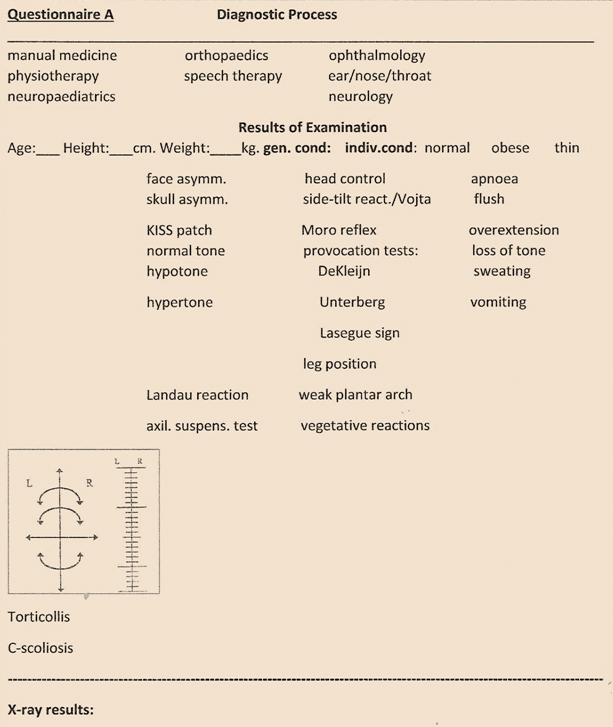
Illustr. 1 KISS questionnaire A To verify the internal consistency of this test in its preliminary form, a pilot study was conducted at the end of 1996/beginning of 1997 to record and evaluate the data of 117 patients that had been referred to the practice with suspected KISS syndrome. Results The results of the pilot study are to be presented here. First the data collected in the sample are described. Then the groups of characteristics that were identified using intercorrelation matrixes are presented. Subsequently attention focusses on connections between x-ray results and the boxes ticked on KISS questionnaire A, and between x-ray results and the characteristic groups identified here. Included in the study alongside the variables seen on the questionnaire are gender, a simple parameter for the social status of the parents, the parents ‘domicile, medical insurance cover, age in months and the child´s place in the order of its siblings. X-ray results were allotted the following variables:
Demographic data In terms of age the sample of patients with suspected KISS syndrome comprised babies of up to one year old (45%), children up to the age of 6 (30%) and 7 – 13 year-olds (25%). There was an unequal distribution in gender, 36% being girls and 64% boys. There was a normal distribution in social status, with the environment tending to account for a higher status. 48% of the patients came from small towns, 25% from rural areas and 25% from cities. 27% came from within the area, 20% travelled between 50 – 100 km, 50% made a journey of between 100km and 300km and the remaining 3% lived even further away. 51% of the patients were the eldest sibling, 35% were the parents ‘only child, 15% had one sibling. Of those patients that were the younger of two siblings (40%) 37% came from two- sibling-only families. Third sibling children made up only 7.7%. 23% of patients had had KISS syndrome in the family, 2.6% had had SID in the family; there had been sensory and motor function disorders in the families of 12% of the patients and dyslexia and dyscalculia in 1.4%. 61% of the children examined had been previously treated by physiotherapists. Referrals/recommendations for a chiropractic diagnosis and therapy were given mainly by paediatricians (53%), less often by general practitioners (15%), by layman advisers (13%) and physiotherapists (10%). Descriptive Results To distinguish items derived from anamneses from those derived from medical examination, items were marked (A) or (B) respectively. The distribution of the characteristics concerning pregnancy and birth inquired after in KISS questionnaire A are shown in table 1. Table 1 
The results of questions asked of parents concerning the neurophysiological/orthopaedic and vegetative development of the child are shown in tables 2 and 3.
Table 4 shows delays of a general nature and sensory and motor function anomalies reported by parents when questioned. Table 4 
The results of data collected in medical examinations showed anatomic/orthopaedic, neurological, chiropractic and radiological changes and treatment-induced phenomena (table 5). Table 5 
The percentage incidence took no account of an age factor effect. An example of this is observation of the function of balance. This characteristic was easier to judge in the case of older children than with babies, but as it was also reported in the latter, it was decided not to split the random group to include or exclude the balance function. Experience showed that other observations reported by parents, for example concerning overextension in their babies, became less precise as their child grew older. These and other problems regarding age-related data will be discussed further below. Item groups After a descriptive examination of the total set of Items, these were structured by means of intercorrelation matrices. This quite clearly brought to light four groups, of which the first two bore a close relation to the age of the patients. Overextension / tensed back muscles / opisthosoma equivalent The items in group 1a listed in table 6 indicated statistically significant to highly significant intercorrelations, whereby tension in the back muscles and overextension reactions intercorrelated most closely, a Kendall tau b rating of 0.82. Also correlating with these two items were hair abrasion (A), hypertone (B) and hair abrasion (B) with correlations of 0.50. In addition there was indication of a connection between the Vojta side tilt reaction, muscular asymmetry (A) and flush during treatment, and the other items with a correlation of 0.25. Table 6 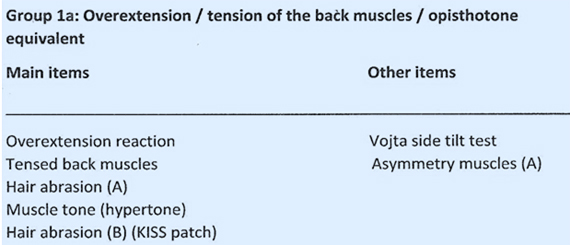
Asymmetry The items in group 1b were not independent of those in the first group, but revealed statistically significant intercorrelations that did not appear in group 1a (table 7). In group 1b asymmetry items came to the fore. Table 7 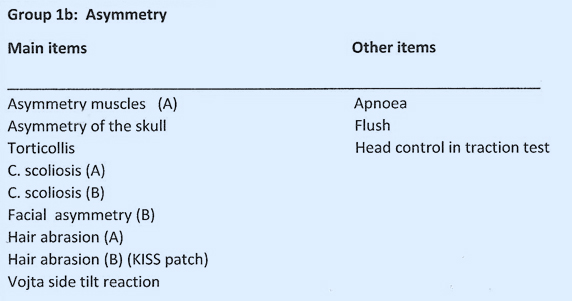
Intercorrelation figures ranged from 0.59 (asymmetry of the muscles with torticollis) to 0.29 (asymmetry of the muscles with flush) and 0.24 (C. scoliosis with untypical head control = traction test). Apnoea was a post-treatment phenomenon (not in group 1a), likewise flush. Tests revealed significant correlations with torticollis, the Vojta side tilt reaction and head control traction test. The splitting up into two item groups discussed above clearly revealed the age factor influence. In the sub-sample of babies (n= 53) only one item group was found (1a + b). The collective item group is shown in table 8. Table 8 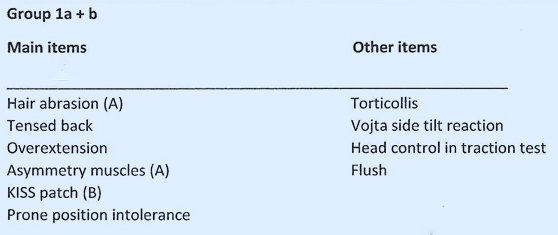
Vegetative item group This group of items (group 2) with its clearly defined structure was made up of items of a vegetative nature (table 9). Intercorrelations were quite high at 0.72 (cry baby with disturbed sleep) apart from connections with drinking disorders which are around 0.25. The items depended on the age factor. Table 9 
No verification method correlated with these items to any statistically significant extent. Mouth closure items This group of items (table 10) was weaker, but nevertheless clearly characterized by the connection between dribbling/slobbering and ‘open mouth’ (0.92, table 10). Pathological eye motor function, frequent infections of the upper air passages and anomalies (x-ray results) correlated at around 0.38 and 0.35 with the main items. Table 10 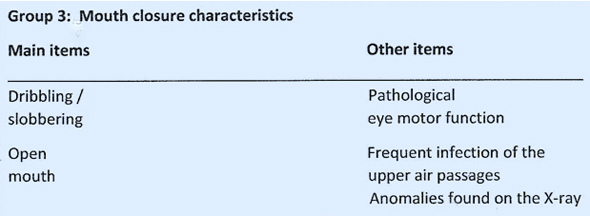
Neither post-treatment phenomena nor verification method correlated significantly with this likewise well-interpretable item group. This group, however, was not as clearly defined as item group 2; there were some correlations with overextension and muscle asymmetry (anamnesis), torticollis (B), muscle tone (B), head control in the traction test and flush. There was no dependency on age. Connections between X-ray results and items in KISS questionnaire A The bone structures shown on x-rays of babies allow an assessment of the relations of occiput, atlas and axis. The next step was dividing up the patients (n = 117) into eight groups according to the results of the x-ray diagnosis (Table 11). Table 11 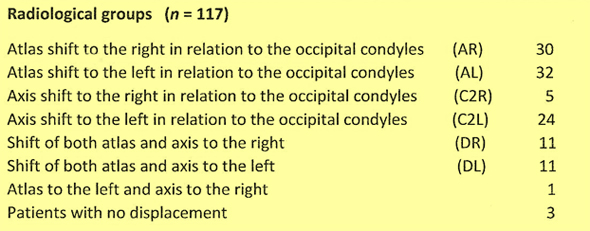
The breakdown of the groups according to age is shown in Table 12. Table 12 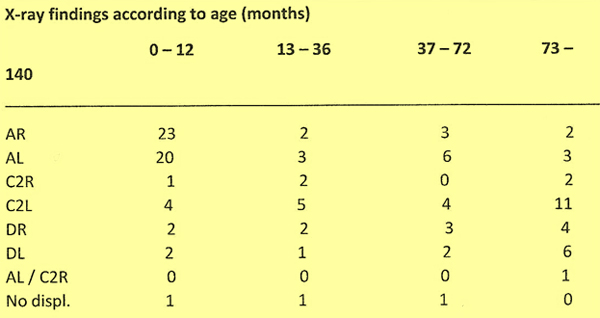
It can be seen clearly that displacement of the atlas only, not the C2, was visible particularly often on the X-rays of babies. This raises the question of whether this quirk is related to the age structure of the patients. The problem of interpreting bone structure, given the low degree of calcification at a baby´s early age, is a familiar one, and the fact that better differentiation is possible at a later age could explain the age-related distribution. Subsequently it was ascertained whether there were correlations between the six relevant groups derived from x-ray results and the characteristics in the KISS questionnaire A (yes / no). The results are shown in terms of their degree of significance and the direction of the connections. They are summarized in Tables 13-18. Six groups of characteristics obtained using intercorrelation matrices were taken into consideration. We distinguished the following characteristic groups: -- 1a: Overextension / tensed back muscles -- 1b: Asymmetry -- 2: Group of vegetative characteristics -- 3: Characteristics of mouth and fauces muscles -- 4: Orthopaedic development -- 5: General development (balance) Overextension and tensed back muscles Overextension and increased back muscle tone were items that correlated positively with the AR and AL groups, whereby AR seemed to be somewhat more affected, especially with regard to the main items tensed back muscles the back muscles and overextension reaction´, which are of particular importance here (Table 13). What was also striking were likewise statistically significant but negative correlations of these items with the C2L group. In this position there was an above-average expectancy of no increase in the tone of the back muscles (opisthotone). This effect cannot be attributed to the age factor alone since the DR and DL groups indicated such to a much lesser degree. Table 13 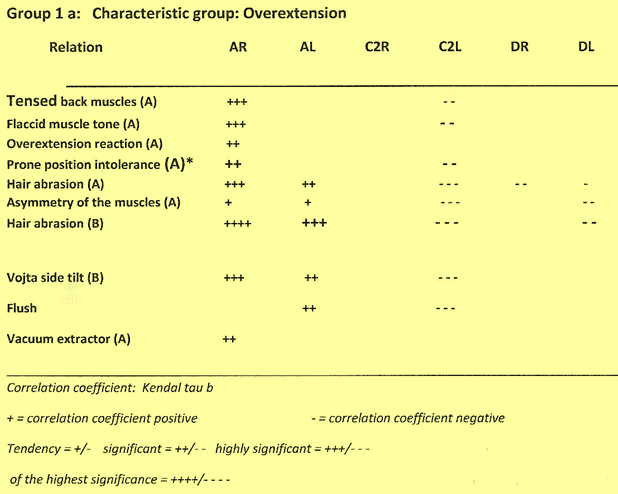
The reaction to the Vojta side tilt test revealed a significant finding in cases of a partial asymmetry of the atlas, irrespective of whether the asymmetry was to the left or to the right. Treatment of AL asymmetry caused a flush to occur. The application of ‘the `vacuum extractor at birth´ recorded in the anamnesis correlated with AR. Age Dependency. In the overall sample all items (with the exception of the anamnesis item ‘vacuum extractor’) depended to a statistically significant degree on the age of the patient. There was no evidence of age dependency in the case of patients over the age of 18 months, accountable to the decision mentioned above to allocate patients with displacements seen on x-rays to a particular age group. Asymmetry Here, too, the displacement of the atlas in relation to the occipital condyles takes centre stage, but with emphasis on AL (Table 14). And although hair abrasion (A) and KISS patch (B) were items also found here, a closer look reveals a difference between this group and the overextension group of items. Torticollis and C. scoliosis (A + B) entered the frame alongside pathological reactions to the Vojta side tilt and traction tests. In addition to flush there was a significant occurrence of apnoea, a vegetative side effect, upon treatment. Table 14 
The negative correlations were particularly evident in the case of C2L (asymmetry). This shows that when there is a double displacement of both atlas and axis to one and the same side, items characteristic of the asymmetry group occur less frequently. The items listed in the asymmetry group, if babies were included, depended to a statistically significant degree on age (most of all where torticollis and traction test were concerned (0.60 and 0.53 respectively)). There was no age dependency with the C. scoliosis items in the case of patients over the age of two years. The results above show that the dominant feature in the asymmetry characteristic group is a displacement of the atlas to the left (no displacement of C2) diagnosed especially in babies. Vegetative characteristics In this small, sharply defined group of characteristics in the vegetative domain AR was much in evidence (Table 15). There was no displacement of the atlas to the left. It was statistically significant that the symptoms of this group did not occur in the case of DL, a finding that cannot be attributed to age because responses to this item were given irrespective of the age of the patients. These items did not correlate with those of overextension or asymmetry, nor in the sub-sample of babies. There was no evidence of any dependency on age. Table 15 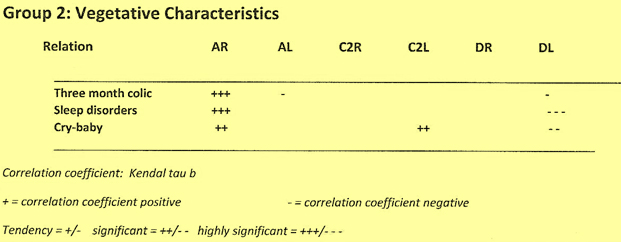
This group of characteristics is connected specifically with a displacement of the atlas to the right. Mouth Closure Responses to these items were not dependent on the age of the patient. They did, however, as mentioned above, correlate with some items in the first two groups to a statistically significant degree. Table 16 
These characteristics occurred in connection with a displacement to the right, to be seen most clearly in the case of C2R (axis shift to the right), but also evident in DR (a shift of both atlas and axis to the right) (Table 16). The exception was the item ‘cry-baby’, which also occurred where there was a shift of the atlas to the right. There was no age dependency, but the items were not completely independent of all items in the ‘overextension’ and ‘asymmetry’ groups of characteristics. Characteristics group: orthopaedic development This group (Table 17) comprises the items which correlated with a displacement of the axis C2 to the left, including a number of characteristics pertaining to orthopaedic development, i.e. the upright bearing of the growing child. There was, however, also a statistically significant correlation with items measuring characteristics of child development in the performance domain. One explanation for this might be that it is the orthopaedic problems that are responsible. There seemed to be a noticeable lack of any occurrence of the items in this group in cases where the atlas was displaced to the right. This effect was partly age-dependent. Consideration of aetiological findings indicated a link, albeit a very weak one, to breech birth. Table 17 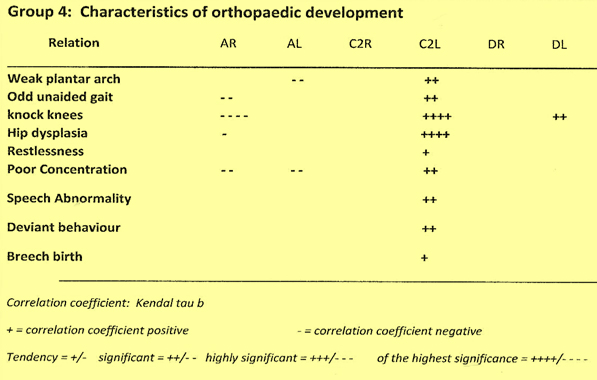
Only hip dysplasia and foot malposition were findings of the first 12 months; the most frequently occurring characteristics were not noticed until later. The items in the orthopaedic development group occurred frequently where there was a displacement of the axis (C2) to the left. They were most frequently to be found in patients upwards of 1 year. These same items were particularly rare where the atlas was displaced to the right. General development The items in this group were found to bear a clear connection to cases of double displacement (Table 18). They seemed to occur particularly frequently where the head joints were displaced to the left. Balance was severely affected (irrespective of right or left). Differences between DR and DL were to be found in fine motor control, enuresis and shyness. In both cases further blockages were to be found in addition to pelvic ring blockages. Of statistical relevance was the finding that caesarean births were more frequent among DL patients. A cephalhaemotoma occurred more often with DR. Patients with DR were more often post-maturity births. A large number of the items listed here occurred considerably less often in patients in whom only the atlas alone was displaced. Table 18 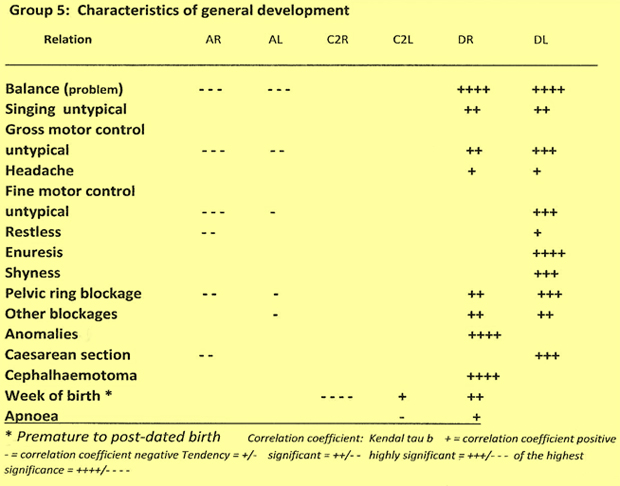
Items from the group of characteristics of general development (‘balance’) came noticeably to the fore where double displacement was concerned. DL asymmetry gave rise to considerably more symptoms, in particular disorders in fine motor control, which is important for a child´s further development. Double displacements to either side required urgent treatment in view of the accompanying symptoms. The items which could not be clearly allocated with the aid of intercorrelation matrices could quite plausibly be put into groups according to x-ray results. These are items that can only be recorded. Once patients have reached a certain age and are therefore a priori age-dependent. Résumé The results in Table 19 strongly suggest that overextension and asymmetry in the case of babies is a problem of an isolated displacement of the atlas. There is a greater tendency towards a displacement of the atlas to the right in the overextension group of characteristics, a tendency towards a displacement of the atlas to the left is to be found in the asymmetry group of characteristics. Table 19 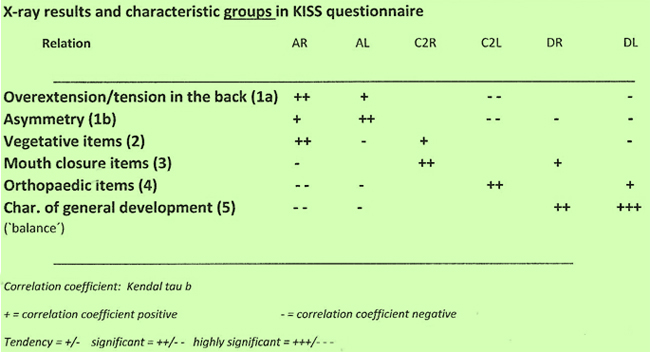
Both types of displacement are diagnosed in babies with a frequency high above the overall average. Vegetative problems are related to displacements to the left, in particular of the atlas. Likewise, mouth closure characteristics also seem to indicate a problem associated with a displacement to the right, in particular a C2R, less so in the case of a double displacement (DR). Orthopaedic problems are seen especially in connection with C2L. Balance and other characteristics crucial to the healthy development of a child are greatly affected by double displacements. A striking feature is the inverse findings for C2L and AR in three of the characteristic groups, even more noticeable in the case of DL and AR in five of the characteristic groups. These are partly due to an age-related influence, but this effect alone cannot possibly explain all such inverse findings. Further investigation would be required here, however, before attempting to form any hypothesis. Discussion As the name pilot study implies, this has been a first attempt to structure the complex nature of KISS-related symptoms and to identify patterns and connections. Examination of the inner consistency of the items recorded in the KISS A questionnaire reveals clear structures. In total six groups of characteristics were found that bore some connection to asymmetries found in X-rays of the upper cervical joints (C0 / C2 region) (Table 19). The information that this questionnaire brings to light, in combination with an evaluation of the X-ray results, provide important indicators for the chiropractic treatment of infants and babies, resulting in a greater degree of diagnostic certainty. Age Dependency A number of the items filed were found to be clearly age-dependent. Parent responses to questions on items concerning overextension / tensed back muscles and asymmetry must be accorded less relevance when the items in question were observed in the first twelve months of the child´s life but reported at a later stage at the time of the questionnaire. These results suggest it would be better to divide the KISS questionnaire up into age groups. Dividing age groups into ‘up to 12 months’ and ‘up to 72 months and older’ would be a possibility, and is under consideration. Rare Symptoms This sample could not shed light on the relevance of rarely occurring symptoms. Clarification of this issue will have to be left to further investigation. Radiological and clinical characteristics In spite of the limitations mentioned regarding the validity of some results, it can be seen that KISS syndrome is likely to impair the healthy development of a child. This is especially likely to be the case where there is a double displacement. DR and DL (found in the x-rays) correlate so strongly with the balance disorder item (disturbances of the vestibular system) that these connections may be considered to be statistically verified. Motor disorders Further important correlations of DR and DL with impairments in the motor domain, singing, headaches and shyness add to the impression that a double displacement to some extent impedes a child´s normal development from the outset, whereby there are differences between the two types of double displacement. What is particularly noteworthy in this connection is that fine motor control only appears to be impaired by a double displacement to the left. This finding should be looked into more closely in view of its relevance to dyslexia in particular. As previously mentioned, results relating to displacement of the atlas alone – often diagnosed in babies – cannot as yet be clearly evaluated because it is possible that double displacements could feature among them. It has, however, nevertheless been established that overextension / tensed back muscles and asymmetry are apt to impair a child´s development. Further characteristics The other three groups of characteristics, ‘vegetative characteristics’, ‘mouth closure characteristics’ and ‘orthopaedic characteristics’ allow for a clearer evaluation because there is much less age dependency here. The very clearly demarcated group of ‘vegetative characteristics’ is seen to be clearly connected to a displacement of the atlas to the right, less frequently, however, when the second cervical vertebra is displaced. Statistics show that mouth closure is often traced back to C2R. Results show that orthopaedic characteristics are related to C2L. Groups of characteristics When evaluation of the data from the pilot study began, it was not expected to bring forth such well-interpretable groups of characteristics. We were even less expecting to find the statistically derived groups to be so clearly linked to the various X-ray results. What were initially surprising findings have turned out to be plausible, replicable and useful criteria for better diagnosis and therapy. Bibliography 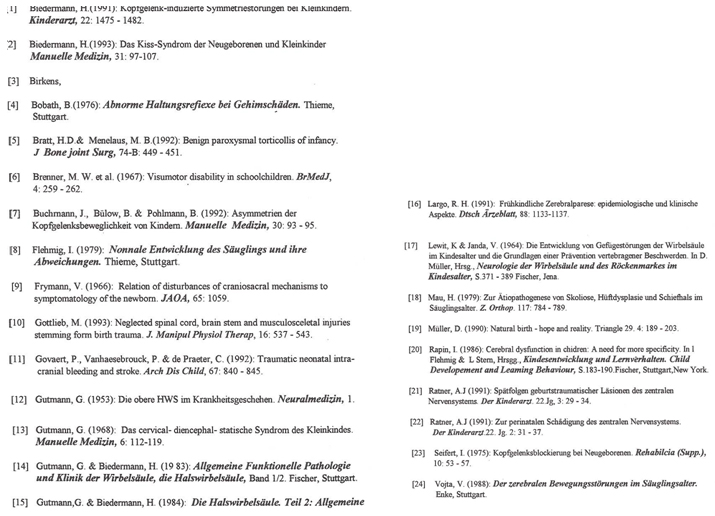
If the correlations are requested, please contact (e-Mail: s.graumann-brunt@t-online.de) Please be aware of the significant negative correlations, which are as important as the positive ones. In the article the correlations with the status of the parents are excluded (if requested, please contact). |


